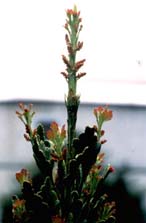 Apical foliage on an ornamental specimen [C.J. Earle, May-1999]. |
Phyllocladus alpinus Hooker 1853
Common NamesMountain toatoa (1).Taxonomic notesSyn: P. aspleniifolius var. alpinus (1), P. trichomanoides var. alpina Parlatore 1868. P. alpinus is polymorphic and possibly several varieties with different geographical ranges are included in the present description. Adequate comparison of New Zealand forms with those of the Tasmanian P. aspleniifolius have not been made (2).Description"Monoecious shrub or tree up to 9 m, trunk short, up to 4 dm diameter. Phylloclades alternate to subopposite, rhachis short. Leaves of seedlings and juveniles up to 1.5 cm, narrow-linear, acute, deciduous, of older plants shorter. Phylloclades of juvenile plants up to 2 cm long, deeply divided, thin, with narrow-linear segments, glaucous below; of adults thick, coriaceous, 1-2.5 cm, occasionally up to 6 cm long, 2 cm wide. Phylloclade shape various; narrow-rhomboid or spathulate, sparingly or much lobed, often elliptic to obovate, cuneate at base, apex subacute to broad-obtuse, margins crenate, leaf-denticles small. Male strobili 5-6 mm long in fascicles of 2-5, rarely solitary, apical, with pedicels 1-2 mm long; sporophylls with small variously shaped apiculi, stems erose. Carpidia densely clustered toward bases of phylloclades, or marginal, rarely solitary; receptacle of red, fleshy scales; mature heads ca. 6-7 mm diameter. Seeds nutlike, black, exserted, ovoid, compressed, ca. 2.5 mm long, obtuse; cupule white, irregularly lobed, up to 2/3 length of seed" (2).RangeNew Zealand: N and S Islands from latitude 36° 50' southwards at 500-900m elevation. Found in subalpine and scrub forest; also lowland forest in west of S Island. Type locality: Nelson (1, 2).Big TreeOldestOne tree-ring chronology, presumably based on living tree material, covers 259 years (6).DendrochronologyDevelopment of tree-ring chronologies apparently began a collection in the 1970s at Pegleg Creek (S Island: 42°S, 171°E; 279 years) by Dunwiddie (3). P. alpinus tree ring data have been used in a study of climate change in New Zealand over the last thousand years (4). The most recent survey of dendrochronological work with the species is provided by Norton and Palmer (5).EthnobotanyObservationsRemarksSee also Paleobotany of Australia and New Zealand conifers.Citations(1) Silba 1986.(2) Allan 1961. (3) Dunwiddie 1979. (4) Burrows and Greenland 1979. (5) Norton & Palmer 1992. (6) International Tree-Ring Data Bank, chronology NEWZ017, limiting dates 1717-1976. |
|
[Phyllocladus] [Podocarpceae] [home] This page is from the Gymnosperm Database
|